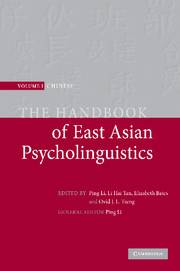Book contents
- Frontmatter
- Contents
- List of figures
- Notes on contributors
- Preface
- Introduction: new frontiers in Chinese psycholinguistics
- Part I Language acquisition
- 1 Actions and results in the acquisition of Cantonese verbs
- 2 Chinese children's knowledge of the Binding Principles
- 3 Chinese classifiers: their use and acquisition
- 4 Child language acquisition of temporality in Mandarin Chinese
- 5 Second language acquisition by native Chinese speakers
- 6 Making explicit children's implicit epilanguage in learning to read Chinese
- 7 Emergent literacy skills in Chinese
- 8 Basic syntactic categories in early language development
- 9 Growth of orthography-phonology knowledge in the Chinese writing system
- 10 Interaction of biological and environmental factors in phonological learning
- 11 The importance of verbs in Chinese
- 12 Grammar acquisition via parameter setting
- 13 Early bilingual acquisition in the Chinese context
- Part II Language processing
- Part III Language and the brain
- Epilogue: a tribute to Elizabeth Bates
- References
- Name index
- Subject index
9 - Growth of orthography-phonology knowledge in the Chinese writing system
Published online by Cambridge University Press: 05 June 2012
- Frontmatter
- Contents
- List of figures
- Notes on contributors
- Preface
- Introduction: new frontiers in Chinese psycholinguistics
- Part I Language acquisition
- 1 Actions and results in the acquisition of Cantonese verbs
- 2 Chinese children's knowledge of the Binding Principles
- 3 Chinese classifiers: their use and acquisition
- 4 Child language acquisition of temporality in Mandarin Chinese
- 5 Second language acquisition by native Chinese speakers
- 6 Making explicit children's implicit epilanguage in learning to read Chinese
- 7 Emergent literacy skills in Chinese
- 8 Basic syntactic categories in early language development
- 9 Growth of orthography-phonology knowledge in the Chinese writing system
- 10 Interaction of biological and environmental factors in phonological learning
- 11 The importance of verbs in Chinese
- 12 Grammar acquisition via parameter setting
- 13 Early bilingual acquisition in the Chinese context
- Part II Language processing
- Part III Language and the brain
- Epilogue: a tribute to Elizabeth Bates
- References
- Name index
- Subject index
Summary
Introduction
The vocabulary of Chinese is represented with a vast number of visually complex characters. Because Chinese does not have grapheme–phoneme correspondence rules in pronunciation, it has been assumed, for a long time, that Chinese children acquire characters by memorization. However, recent studies have provided strong experimental evidence that, just as in learning to read alphabetic scripts, an understanding of the nature of the correspondence between print and sound is crucial in learning Chinese characters (Tzeng, 2001). Research also reported that all children, regardless of types of reading instruction they receive and types of written scripts (traditional or simplified), learn to develop similar knowledge of relationships between orthography and phonology (Ho & Bryant, 1997; Shu, Anderson & Wu, 2000; Tzeng et al., 1995).
In the past two decades, one of the most important discoveries in psycholinguistic research is the role of phonological awareness in learning to read alphabetic languages. Experimental studies have indicated that children's knowledge of the linkage between orthography and phonology forms the foundation of reading acquisition. Reading difficulties found in dyslexic children are mainly due to their failure to form a good knowledge of orthography and phonology (Goswami & Bryant, 1990; Snowling et al., 1986). Recent years have seen an increasing interest in the study of language and reading acquisition through database analysis and connectionist models (Seidenberg & McClelland, 1989).
- Type
- Chapter
- Information
- The Handbook of East Asian Psycholinguistics , pp. 103 - 113Publisher: Cambridge University PressPrint publication year: 2006
- 9
- Cited by



